You've probably gotten quotes ranging from $3,000 to $300,000 for your manufacturing website. Maybe you're wondering if the expensive agencies are overcharging or if the cheap options are cutting corners. The truth is, both could be right depending on what you actually need.
Getting a straight answer about manufacturing website costs feels impossible because every vendor seems to speak a different language. Some talk about templates and hosting, others about enterprise integrations and custom applications. Meanwhile, you just need to know what you should realistically budget for a website that helps your manufacturing business grow.
After 20+ years of building websites for manufacturers, we've learned that the right investment depends entirely on your specific situation. Your product complexity, market position, and growth plans all play a role. This guide breaks down the real costs you should expect, what drives those costs, and how to make sure you're investing wisely.
We'll walk through actual price ranges, explain what you get at each level, and help you figure out where your company fits. No sales pitches, no vague ranges, just honest information to help you plan your budget and make the best decision for your business.
The Real Cost Ranges for Manufacturing Websites
Basic Manufacturing Website ($5,000-$20,000)
At this price point, you're getting a professional foundation that works well for smaller manufacturers or those just establishing their digital presence. These websites typically include 10-30 pages with clean, professional design and basic functionality. You'll have a clear presentation of your capabilities, product categories, and contact information.
This level works perfectly for job shops, single-location manufacturers, or companies with straightforward product lines. You'll get mobile-responsive design, basic SEO setup, and a content management system so you can make updates yourself. The timeline usually runs 6-8 weeks from start to launch.
The limitations become clear when you need advanced functionality. You won't have sophisticated product catalogs, customer portals, or system integrations at this price. Photography is often limited to existing assets or stock images, and content development focuses on organizing what you already have rather than creating new materials.
Path Robotics: A Strong Example of a Basic Manufacturing Website
Path Robotics, a manufacturer of autonomous welding robots, features a modern manufacturing website that immediately establishes credibility. The homepage pairs bold messaging with a clean hero section that highlights both the technology and the company’s manufacturing environment.
Authentic visuals, thoughtfully integrated videos, and the inclusion of a resource section demystify the autonomous welding process and support the buyer’s research journey. The site loads quickly and is intuitively organized, making it easy for technical buyers to move between product information and educational content.

While the overall experience is polished, the site’s navigation is simple, product-specific content is limited, and pages are few. This type of website is ideal for manufacturers without complex product lines who do not need a significant number of web pages.
Professional Manufacturing Website ($20,000-$40,000)
This is where most growing manufacturers find their sweet spot. You're getting custom design that truly reflects your brand, professional copywriting that explains your complex offerings clearly, and enough functionality to support serious business development. These sites typically include 30-75 pages with room for growth.
Professional sites at this level include robust product showcases, downloadable resources like spec sheets and CAD files, and basic integration capabilities. You might connect your contact forms to your CRM, set up email automation, or create password-protected areas for distributors. Professional photography for key products and facilities becomes part of the package.
Companies ready for this investment typically have multiple product lines, sell nationally or internationally, and need their website to actively generate qualified leads. The development timeline extends to 10-14 weeks to accommodate strategy, custom design, content development, and testing.
Advanced Manufacturing Website ($40,000-$80,000)
Advanced manufacturing websites serve companies with complex needs that go beyond standard functionality. These sites become true business tools, not just marketing platforms. You're looking at 75-200+ pages with sophisticated organization and search capabilities that help customers find exactly what they need among hundreds or thousands of products.
At this level, you're getting serious integrations with your business systems. Your website can display real-time inventory from your ERP, sync customer data with your CRM, or provide customized pricing for logged-in distributors. Multi-language capabilities let you serve global markets properly, with professionally translated content and localized user experiences.
The investment includes comprehensive content development, professional industrial photography or 3D renderings, and often video production. Development timelines typically run 16-20 weeks due to the complexity of integrations, custom functionality development, and extensive testing across all systems.
Misco Speakers: An Example of Sophisticated Product Architecture
Misco Speakers offers a feature-rich website that supports both custom OEM solutions and off-the-shelf products. Comprehensive product specifications speak directly to engineers, researchers, builders, and contractors who rely on precise data when evaluating components. The site’s navigation menu is much more robust, and the customer account feature ensures users can easily track orders, manage preferences, and stay connected with Misco’s brand.

Misco’s product catalog page offers advanced filtering options, including category, speaker type, size, shape, nominal impedance, and more. This enables technical buyers to narrow results quickly. Prospects can also sort by position, product name, price, size, or frequency response to easily surface the most relevant options.

This level of sophisticated product organization improves usability, reduces friction in the research process, and ensures buyers can immediately identify the components that fit their requirements. For manufacturers with complex product lines, Misco’s approach offers a strong model for structuring catalog data in a way that accelerates decision-making.
Enterprise Manufacturing Website ($80,000+)
Enterprise websites represent major digital transformation projects for large manufacturers or those with highly complex requirements. These aren't just websites – they're comprehensive digital platforms that might include customer portals, e-commerce capabilities, product configurators, and complex quoting systems. You're building critical business infrastructure that happens to live on the web.
These projects often involve multiple stakeholders, extensive discovery phases, and careful integration with numerous enterprise systems. You might be connecting SAP or Oracle backends, building custom applications for product configuration, or creating sophisticated dealer networks with different access levels and pricing structures. The page count becomes less relevant than the depth of functionality.
Enterprise projects require specialized expertise and larger teams. Timelines often extend beyond 6 months and may involve phased rollouts. The investment makes sense when your website needs to handle complex B2B transactions, support extensive product customization, or serve as the primary interface between your company and customers globally.
What Drives Manufacturing Website Costs?
Complexity of Your Product Line
The difference between showcasing 20 products and 2,000 products isn't just about creating more pages. Complex product lines require sophisticated organization, intelligent search functionality, and careful information architecture. Each product might have multiple variants, technical specifications, compatibility requirements, and related accessories that all need logical presentation.
Present Tools to Guide Customers Through the Selection Process
When you manufacture products with numerous configurations or custom options, your website needs to guide customers through selection processes without overwhelming them. This might mean:
- Interactive product selectors
- Comparison tools
- Guided selling experiences
The backend needs to maintain all these relationships while keeping content manageable for your team.
Offer Clear and Organized Technical Specs
Technical specification displays add another layer of complexity. Engineers and technical buyers expect detailed information that is organized properly and presented clearly. This includes:
- Data sheets
- Performance curves
- Dimensional drawings
- Material specifications
The more complex your products, the more sophisticated your website needs to be to serve your technical audience effectively.
Hockmeyer’s Horizontal Paste Mixer: An Effective Technical Product Page
Here’s an example of a product page from Hockmeyer featuring their horizontal paste mixer. The page first provides a detailed summary of the high viscosity mixer, outlining ideal applications along with key product features and benefits that matter to technical buyers.
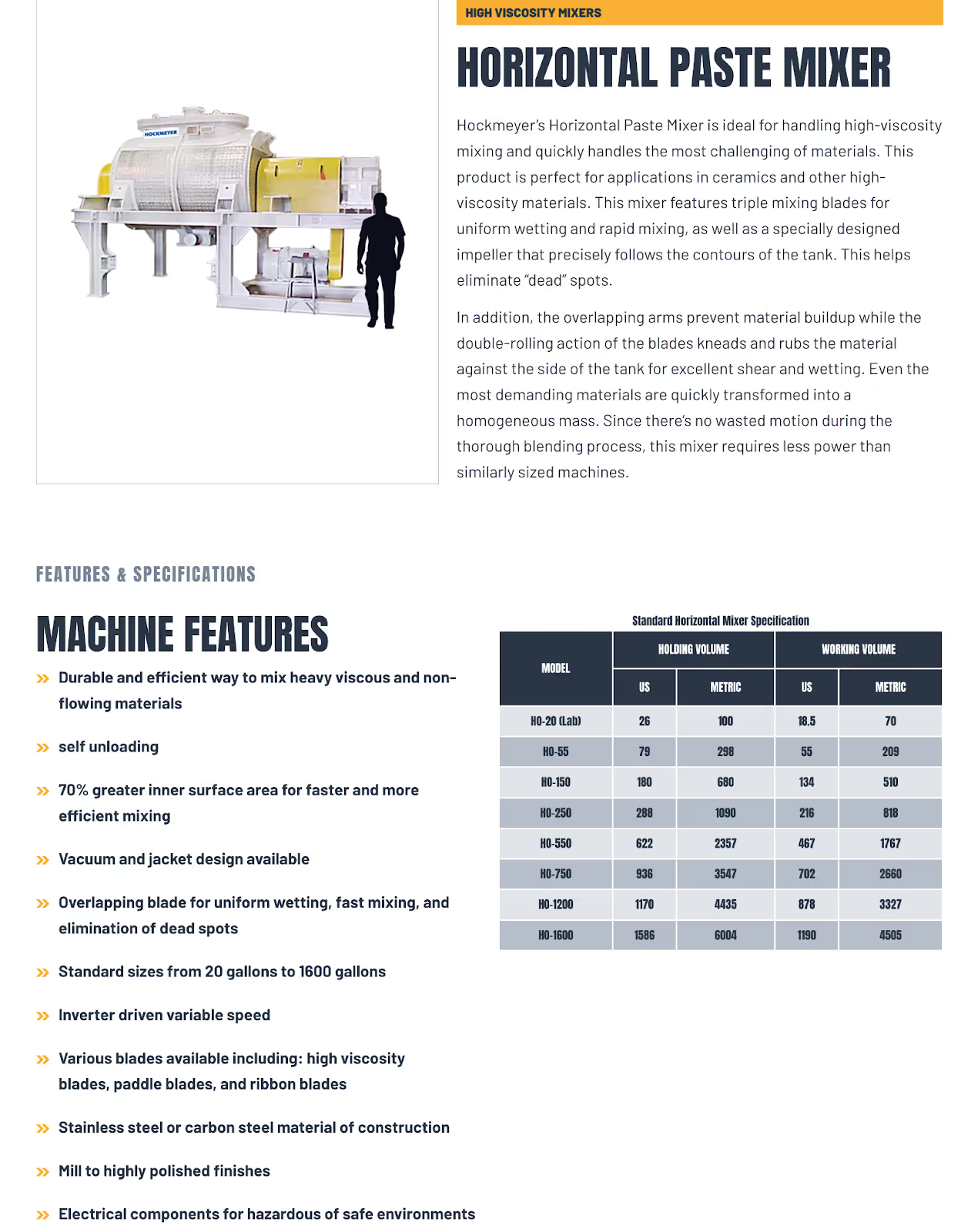
Below the summary, prospects can explore detailed machine highlights, like how the mixer’s 70% greater inner surface area enables faster and more efficient mixing. A comprehensive chart provides all the technical specifications prospects need to make an informed buying decision, such as the holding volume and working volume. Volume capacities are presented in both U.S. and metric units for global accessibility.
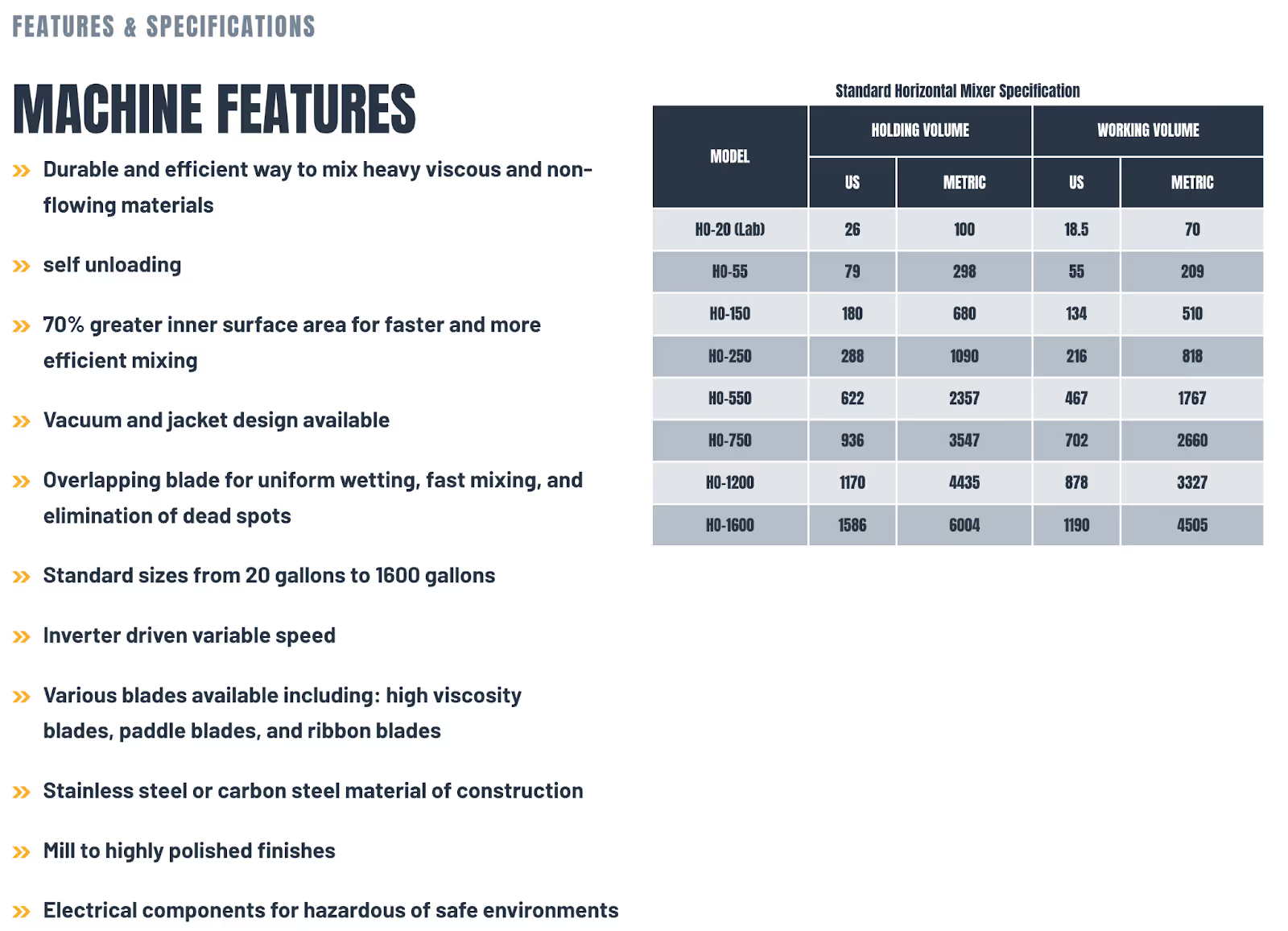
The product page also offers an image gallery, links to relevant services, and a clear CTA for prospects who are ready to schedule product testing.
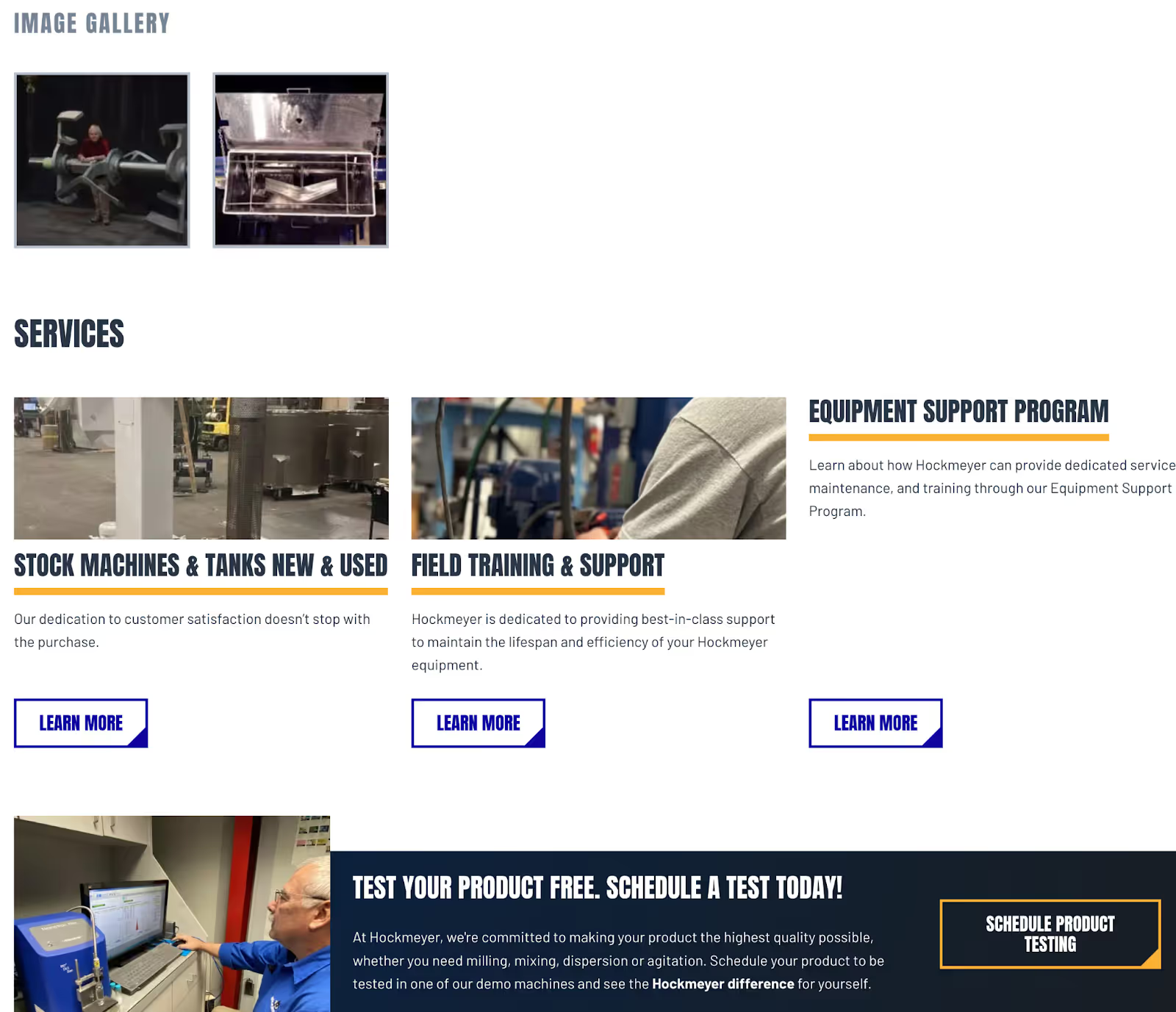
Hockmeyer’s product page demonstrates how well-structured technical content can guide buyers through the technical evaluation process with ease.
Visual and Media Complexity
Manufacturing websites live or die by their visual presentation. The right visuals clarify complex processes, highlight craftsmanship, and build credibility with buyers.
Professional Photography
Your products might be highly technical, but buyers still need to see what they're purchasing. Professional industrial photography shows your capabilities and quality standards while building trust with potential customers. A single day of professional photography might cost $3,000-$8,000, but the impact on your website's effectiveness justifies the investment.
Interactive Product Visualization
Some manufacturers need to go beyond static photography:
- 360-Degree Views or Interactive 3D Models: Perfect for complex machinery, these visualizations let customers explore products in detail
- Animation: Animation demonstrates how products work or how components fit together
- Facility Tour Videos: Videos like these give customers confidence in your capabilities without requiring visits to your site location
Background Videos
Background videos have become increasingly important for creating emotional connections with visitors. You can immediately communicate professionalism and capability with a well-produced video of your:
- Manufacturing floor in action
- Team at work
- Products in use
Video production costs vary widely, but expect $5,000-$15,000 for professional manufacturing videos that truly enhance your site.
Content Development Needs
Your website copy needs to translate complex technical information into clear benefits that resonate with different audiences. Engineers need specifications, purchasing managers need pricing and availability, and executives need to understand strategic value. Professional technical writers who understand manufacturing can create content that serves all these audiences effectively.
Case Studies and Application Notes
Case studies and application notes require particular attention. These documents prove your capabilities and help prospects envision solutions to their challenges. Each case study might require interviews, technical review, and careful crafting to tell compelling stories while protecting client confidentiality.
Planning for 10-15 comprehensive case studies adds significant value but also adds $5,000-$15,000 to your project.
Multi-Language Capabilities
Many manufacturers serve global markets, which means multi-language capabilities become essential. Professional translation goes beyond running text through Google Translate. Technical terminology needs accuracy, marketing messages need cultural adaptation, and the entire user experience needs to feel native to each market.
Each additional language might add $10,000-$30,000 depending on content volume.
Integration Requirements
Modern manufacturing websites rarely stand alone. They need to connect with your existing business systems to provide real value.
ERP Integration
ERP integration lets you display real-time:
- Inventory
- Lead times
- Pricing
This eliminates the constant "call for pricing" messages that frustrate customers and creates efficiency for your sales team.
CRM Integration
CRM integration ensures every lead, form submission, and customer interaction flows directly into your sales pipeline. Your sales team gets complete context about what:
- Products prospects showed interest in
- Content they downloaded
- Pages they visited
This intelligence helps them have more relevant conversations and close deals faster.
Quote Request System Integration
Quote request systems need special attention in manufacturing. Unlike simple contact forms, quote requests often involve:
- Multiple products
- Specific quantities
- Custom requirements
- Technical specifications
Building systems that capture this complexity while remaining user-friendly requires careful planning and significant development time.
Technical Documentation Management
Manufacturers generate enormous amounts of technical documentation. Every product might have specification sheets, installation guides, safety data sheets, CAD drawings, and compliance certificates. Your website needs to organize these documents logically while keeping them updated as products evolve.
Version Control
Version control becomes critical when customers rely on your documentation for design and specification decisions. You need systems that ensure customers always access current information while maintaining archives when needed. This might mean integration with document management systems or building custom solutions for your specific needs.
Security Measures
Security adds another layer when dealing with proprietary information or controlled technical data. Some documents need password protection, others might require user registration, and certain materials may have geographic restrictions. Building these access controls while maintaining good user experience takes careful planning and robust development.
Hidden Costs to Consider
Website Performance and Speed
Your beautiful new website won't help if it loads slowly. Manufacturing websites often feature large images, technical documentation, and product catalogs that can bog down performance.
Content Delivery Networks
Content delivery networks (CDNs) distribute your content globally so international visitors get fast load times. Expect $100-$500 monthly for CDN services depending on your traffic and content volume.
Image Optimization
Image optimization requires ongoing attention. Your product photos might be beautiful at full resolution, but they need intelligent compression and multiple size variants for different devices.
Many manufacturers underestimate the ongoing effort required to process and optimize new product images as their catalog grows. Some invest in automated image processing systems that add $200-$500 monthly but save hours of manual work.
Ongoing Maintenance
Websites aren't "set it and forget it" investments. You’ll need to devote regular attention to:
- Security updates
- Software patches
- Compatibility fixes
Most manufacturers budget $500-$2,000 monthly for maintenance, depending on website complexity. This ensures your site stays secure, functions properly, and maintains compatibility as browsers and devices evolve.
Content Management
Content management often surprises manufacturers with its ongoing demands. Consider that:
- Product specifications change
- New products launch
- Old products retire
- Case studies need updating
While your CMS lets you make these changes yourself, many companies find dedicating internal resources challenging. Consider whether you'll handle updates internally or need ongoing support from your web partner.
How Fresh, High-Value Content Supports Rankings and Engagement
GE Aerospace is one B2B manufacturing company that demonstrates the power of consistent content creation and site updates. The site’s “News” section features articles on topics that appeal to their target demographic, along with press releases that keep both prospects and current clients informed about new developments.
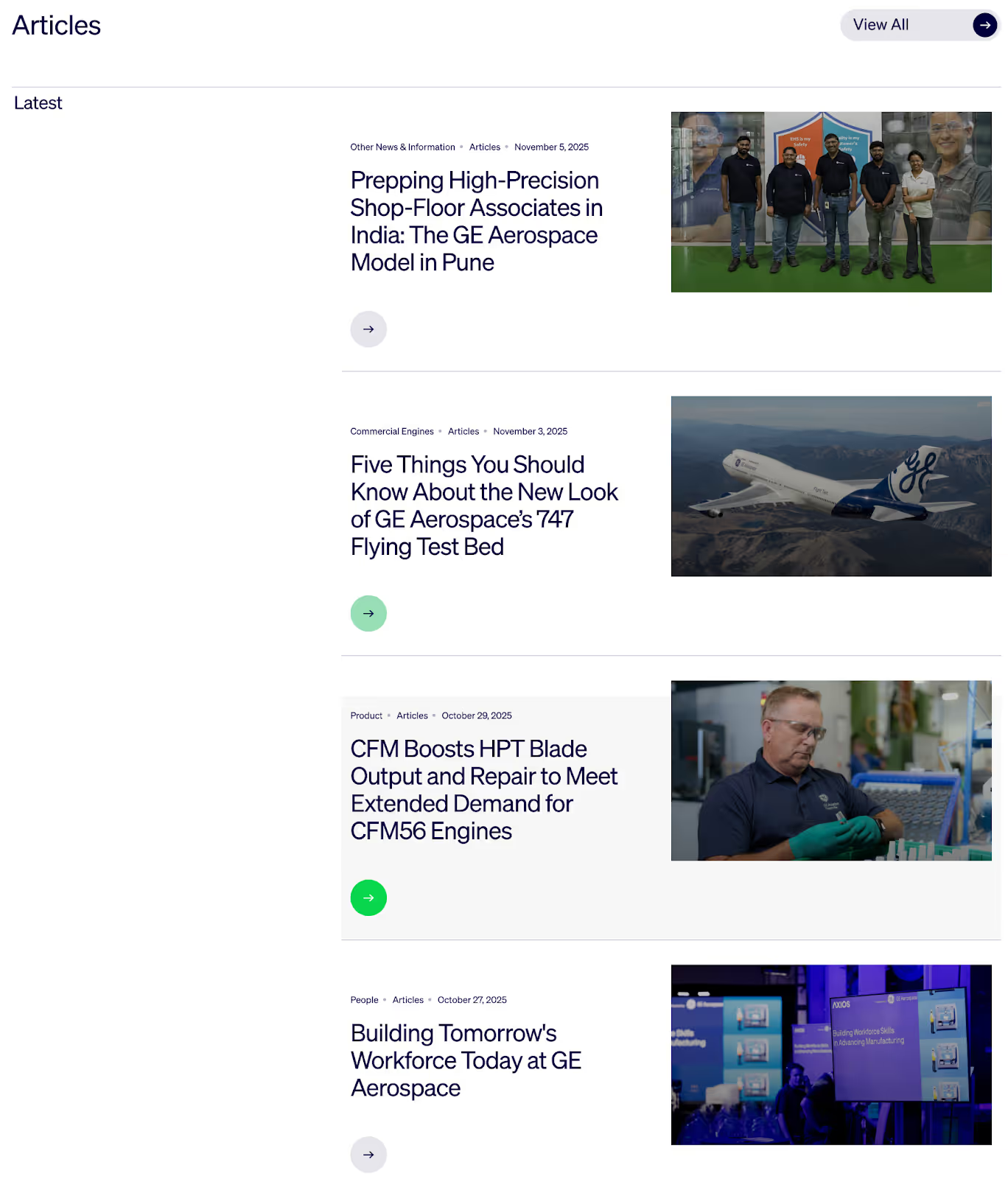
By regularly publishing new content and optimizing existing content, GE Aerospace keeps its website fresh, signals relevance to search engines, and strengthens its overall visibility. This approach helps brands stay competitive in rapidly evolving industries like manufacturing.
Marketing and Traffic Generation
Building a great website means nothing if nobody visits it. Search engine optimization and digital advertising help you appeal to your target market and generate traffic to your website.
Search Engine Optimization (SEO)
SEO helps potential customers find you when searching for solutions. Basic SEO comes with most web projects, but ongoing optimization requires continuous effort. Manufacturing companies typically invest $1,000-$5,000 monthly in SEO to maintain and improve rankings.
PPC Advertising
Many manufacturers supplement organic traffic with pay-per-click advertising. Setting up effective campaigns for technical products requires expertise and ongoing optimization. Initial setup might cost $2,000-$5,000, with monthly management fees of $500-$2,000 plus your actual ad spend. These campaigns can deliver immediate traffic while your SEO efforts build momentum.
How to Evaluate Manufacturing Website Quotes
Red Flags in Low-Cost Proposals
Red Flag #1: Extremely Low Quotes
Extremely low quotes often signal corners being cut in ways that hurt long-term success. Template-only solutions without customization might work for simple businesses but rarely serve manufacturers well. Your complex products and technical audiences need more thoughtful presentation than generic templates provide.
Red Flag #2: No Discovery or Strategy Phase
Watch out for proposals that skip discovery or strategy phases. Understanding your business, market, and customers takes time. Vendors who jump straight to design without this foundation often create websites that look nice but don't achieve business goals. The discovery phase might add several weeks to your timeline but pays dividends in effectiveness.
Red Flag #3: Missing Mobile Optimization
Missing mobile optimization should eliminate vendors immediately. Over half your visitors will use mobile devices, especially field engineers and procurement professionals researching solutions. A vendor who treats mobile as optional doesn't understand modern web requirements.
Red Flag #4: Zero Content Development Support
Same goes for proposals lacking content development support – your technical information needs professional translation into effective web content.
What Should Be Included
Detailed Phases
Comprehensive proposals should detail every project phase clearly:
- Discovery and Strategy Phase: This work helps define objectives and success metrics
- Design Phase: This phase should include multiple concepts and revision rounds
- Development Phase: Development needs clear specifications about functionality, testing protocols, and browser compatibility requirements
Content Support
Content support varies by price level but should always include some guidance. Make sure your vendor will help you create effective content, which might include:
- Content templates
- SEO keyword research
- Full copywriting services
Training ensures your team can manage the site after launch, and documentation helps future team members understand the system.
Post-Launch Support
Post-launch support periods give you confidence that help is available as you learn the system. Most professional projects include 30-90 days of support after launch. This covers:
- Bug fixes
- Minor adjustments
- Questions that arise as you start using your new website
Clarify what's included versus what requires additional investment.
Questions to Ask Potential Partners
Experience with manufacturing clients matters more than general web experience. Ask specific questions about manufacturing projects they've completed, like:
- How did they handle product catalogs?
- What platforms have they integrated with?
- Do they understand the technical buying process in manufacturing?
Request references from similar manufacturers and actually call them.
Understanding of your specific industry prevents costly misunderstandings. A vendor who's built websites for medical device manufacturers might not understand heavy equipment sales cycles. Ask:
- How they'll learn your industry
- Who will be doing the work
- What research they'll conduct
The best partners invest time understanding your market before designing solutions.
Choosing a Web Design Partner With Manufacturing Expertise
Look for web design agencies that specialize in B2B or industrial clients. For example, Trajectory focuses on two key client types: B2B companies and nonprofits. On our “Web Design for B2B Companies” page, you’ll find:
- Logos of clients who entrusted us with their website redesigns
- Featured projects in the B2B and manufacturing space
- What sets us apart from other B2B website designers
- Testimonials from satisfied clients
- FAQs
- Step-by-step outline of our B2B web design process
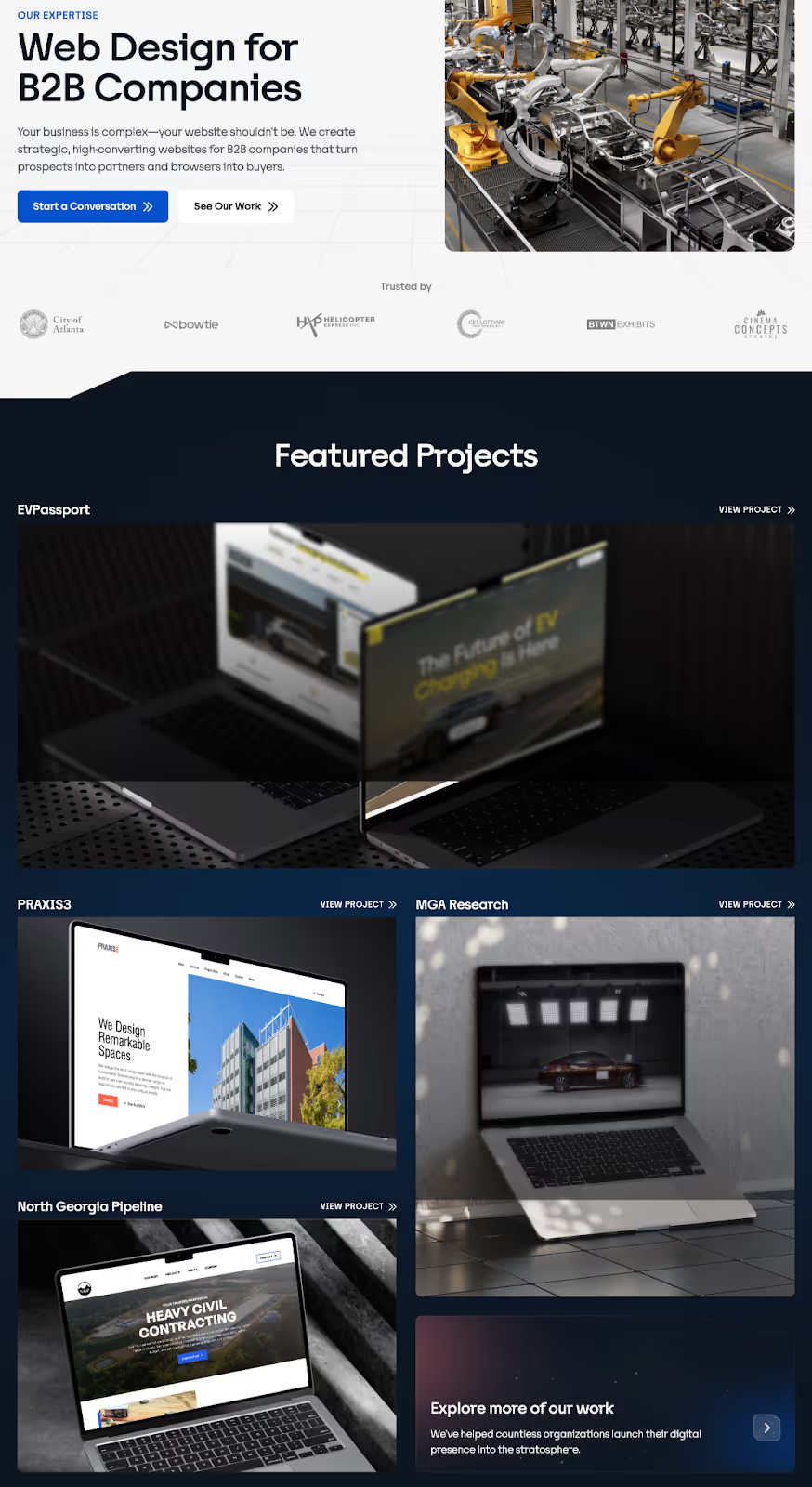
Always review relevant portfolio work when selecting a web partner. This step is essential for understanding whether they can meet the technical, strategic, and aesthetic needs of an industrial brand. For example, our “Featured Website Design Work” page highlights the sectors we’ve worked with, from architecture and aviation to manufacturing and software. Manufacturing prospects can filter by “Manufacturing” to see case studies from the manufacturing sector and explore how we approached each project and implemented solutions to deliver measurable results.

Evaluating resources like these helps ensure you choose a partner capable of building a site that supports your brand and appeals to prospective buyers.
ROI Considerations for Manufacturers
Calculating Potential Returns
Your website investment should generate measurable returns through:
- Increased leads
- Shortened sales cycles
- Improved customer satisfaction
A manufacturer generating $10 million annually might see 20-30% of revenue influenced by their website within two years. Even conservative improvements in lead quality and conversion rates justify significant website investments.
Cost Savings
Consider cost savings alongside revenue generation:
- Self-Service Product Information: Reduces technical support calls
- Automated Quote Requests: Streamline sales processes
- Digital Catalogs: Eliminate printing costs
One manufacturer saved $50,000 annually just in printed catalog costs after launching their comprehensive website. These operational efficiencies add up quickly.
Reduced Customer Acquisition Costs
Customer acquisition costs often drop dramatically with an effective website. Trade shows might cost $25,000 to generate 100 leads, while your website could generate similar volume monthly at a fraction of the cost. The website works continuously, capturing leads while you sleep and qualifying prospects before they contact sales.
Making the Business Case Internally
Frame your website investment in terms executives understand. Compare it to equipment purchases, facility improvements, or hiring decisions. A $40,000 website costing less than one senior employee's annual salary but potentially influencing millions in revenue becomes easier to justify. Show how competitors' digital presence might be winning business you're missing.
Competitive analysis strengthens your case significantly. Be sure to:
- Document what competitors offer online versus your current capabilities
- Show specific examples where prospects might choose competitors simply because their websites provide better information or easier purchasing processes
This defensive argument often resonates when growth arguments don't.
Financing Options and Budget Planning
Payment Structure Options
Milestone-Based Payment Schedule
Most web projects follow milestone-based payment schedules that align with project phases. Here’s an example of a typical payment structure based on development phases:
- Signing: 25-50%
- Design Approval: 25%
- Development Start: 25%
- Launch: Final payment
This spreads cost over your project timeline while ensuring vendors have working capital for your project.
Monthly Payment Plan
Some manufacturers prefer monthly payment plans that spread costs over 6-12 months. This can ease budget impact but might include financing charges.
Phase-Based Development Plan
Phase-based development offers another option, building your site in stages as budget allows. You might launch core functionality first, adding advanced features in subsequent phases.
Budget Planning Strategies
Strategically Time Your Investment
Timing your website investment strategically can maximize impact and minimize disruption. Many manufacturers align projects with fiscal year planning, ensuring budget availability and stakeholder buy-in. Others time launches before busy seasons or major trade shows to maximize initial impact.
Apply for Grants and Incentives
Consider available grants and incentives for digital transformation. Many states offer programs supporting manufacturers' technology investments. Federal programs sometimes provide tax advantages for website development as business infrastructure investment. Your accountant can advise on optimizing tax treatment of your website investment, potentially affecting project timing.
Getting Started with Your Budget Planning
Preparation Checklist
Starting with clear business objectives makes every subsequent decision easier. Follow this preparation checklist to get started with budget planning:
- Define What Success Looks Like: Success may be more leads, better lead quality, shorter sales cycles, or improved customer service.
- Audit Your Current Website's Problems Honestly: Document specific issues affecting business performance. These become your requirements for the new site.
- Distinguish Must-Have Features From Nice-to-Have Additions: Core functionality that directly supports business objectives takes priority, while advanced features can often wait for phase two. Gather input from sales, customer service, and other stakeholders, but maintain focus on primary business goals.
- Compile Existing Marketing Materials: Gather product information, brand guidelines, and other marketing materials to streamline the discovery process.
Next Steps
Gather Quotes
Request quotes with enough detail to make meaningful comparisons. Provide potential vendors with your:
- Objectives
- Target audiences
- General functionality requirements
- Budget ranges (to ensure realistic proposals rather than wish lists)
- Examples of websites you admire, specific features you need, and any systems requiring integration
Establish Realistic Timelines
Set realistic timeline expectations based on your chosen investment level. Rush projects cost more and often deliver less. Plan for:
- Stakeholder review time
- Content development
- Proper testing
- Buffers for unexpected challenges or opportunities that arise during development
Most manufacturers need 3-6 months from project start to launch, depending on complexity.
Final Thoughts: Building Value Through Smart Website Investment
Match Your Investment to Business Complexity
Manufacturing website costs vary dramatically because manufacturing businesses vary dramatically. A small job shop needs different tools than a global component supplier. Your investment should match your:
- Business complexity
- Growth ambitions
- Customer expectations
The ranges we've outlined – from $5,000 basic sites to $80,000+ enterprise platforms – reflect these diverse needs.
Prioritize Value Over Cost
Value matters more than price when choosing your investment level. A $40,000 website that generates qualified leads and shortens sales cycles delivers more value than a $10,000 site that just looks pretty. Consider total return on investment, not just initial cost. Your website works every day, reaching prospects, serving customers, and supporting sales efforts continuously.
Choose a Partner Who Understands Manufacturing
Manufacturing expertise in your web partner matters as much as your budget level. Partners create more effective websites when they understand:
- Technical buying processes
- Complex products
- Manufacturing business models
They translate complexity into clarity, helping your audiences understand your value quickly. This expertise often distinguishes adequate websites from exceptional ones.
Think of Your Website as a Long-Term Asset
Your website represents a long-term digital investment in your manufacturing business's growth. Unlike equipment that depreciates or inventory that turns, your website can appreciate in value as you add content, build authority, and improve functionality. Starting with the right foundation and partner positions you for sustainable digital success.
Take the Next Step
Ready to explore what your manufacturing website should cost? The next step is defining your specific objectives and requirements. With clear goals and realistic budget expectations, you can find the right partner to build a website that truly works for your manufacturing business.

